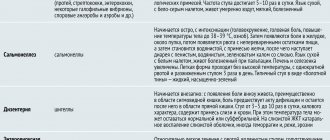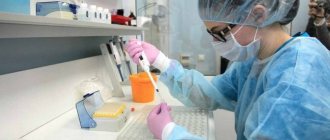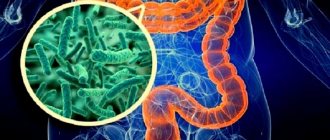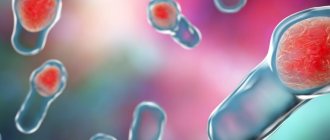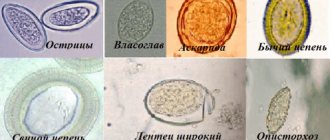Tests for acute intestinal infections
The causative agents of acute intestinal infections are bacteria, viruses and protozoa from various taxonomic groups.
To quickly identify the causative agents of acute intestinal infections, there are special tests for acute intestinal infections, which include molecular genetic studies (including the PCR method) and express methods (antigenic tests for identifying pathogens of acute intestinal infections). These methods make it possible to diagnose acute intestinal infections in the early stages of the disease and when taking antibiotics. As auxiliary tests for acute intestinal infections, serological methods are used to detect specific antibodies to pathogens.
Stool PCR: what is it?
Among tests for acute intestinal infections, PCR diagnostics of stool, also called PCR, occupies a special place. Currently, this is one of the most accurate methods for determining acute intestinal infections, which is clinically tested and time-tested.
So, stool PCR: what is it? Polymerase chain reaction is an experimental method in molecular biology. Even if only a few molecules of pathogen DNA are present in a sample, a technique that can significantly increase small concentrations of certain nucleic acid (DNA) fragments can detect them.
The advantages of stool PCR in determining infectious diseases are as follows:
- the analysis identifies the pathogen not through its waste products, but directly, through a fragment of its DNA;
- a unique DNA code allows you to accurately identify the causative agent of the disease;
- the analysis is highly sensitive and is able to detect the presence of even single pathogen cells;
- stool PCR results can be obtained within 4–5 hours after collecting the biomaterial.
How to diagnose acute intestinal infections?
Acute intestinal infections (AI) are a group of infectious diseases that are caused by viruses, bacteria or parasites.
What these diseases have in common is the fecal-oral mechanism of infection, as well as transmission factors: food, water, infected household items and dirty hands.
The first symptoms appear a few hours or days after infection; they begin abruptly, with the appearance of frequent loose stools, vomiting, abdominal pain, and signs of intoxication (fever, chills, nausea).
According to official statistics, in Russia, up to 65-67% of diseases in this group are AEIs of unspecified etiology, which creates certain difficulties in prescribing drugs for the treatment of these diseases in children and carrying out targeted preventive and anti-epidemic measures.
The frequency of detection of viral and bacterial pathogens depends on age: in children under 3 years of age, viral agents account for 80-90% of diseases, bacterial agents account for 10-20%; Among adult patients, the proportion of viral pathogens decreases to 30%. Most acute viral intestinal infections in children are caused by group A rotaviruses and genogroup 2 norovirus (GII). In the structure of acute intestinal infections of bacterial origin, the most common pathogens in children are salmonella (about 7% of acute intestinal infections), escherichiosis (4.8% of acute intestinal infections), campylobacteriosis (2.9% of cases of diseases), shigellosis (0.3% of cases of acute intestinal infections). infections).
Diarrhea caused by viruses most often progresses favorably with timely treatment and ends with recovery in 3-7 days. Inappropriate use of antibiotics in such patients is not only useless, but also harmful, delaying recovery.
Bacterial diarrhea, unlike viral diarrhea, is characterized by a more severe clinical course. Diseases caused by intestinal pathogenic bacteria may require hospitalization and antibiotic therapy. Young children with diarrhea of any origin very quickly develop intoxication and dehydration, so they are hospitalized, regardless of the cause of the disease, in an infectious diseases hospital.
When acute diarrhea occurs, you always need to find the cause of the disease as quickly as possible in order to decide on the patient’s treatment tactics, or decide whether hospitalization is necessary.
The centralized clinical diagnostic laboratory "Light" offers a modern laboratory diagnostic method PCR (polymerase chain reaction) to identify 8 main pathogens of intestinal infections:
- Astrovirus infection does not have clinical features that allow it to be differentiated from other intestinal infections, but the contribution of astrovirus infection to AII in our country is about 4%.
- Adenoviral infections are distinguished by a variety of clinical symptoms and are associated with 7 groups of human adenoviruses (AG), which unite more than 50 serotypes. Currently, only adenoviruses of group F are demonstrably associated with the symptoms of ACI. In Russia, adenoviruses of group F occupy the 4th-5th place in prevalence among viral agents that cause ACI.
- Norovirus is one of the common causes of outbreaks of AEI of non-bacterial etiology: every second outbreak of AEI and 90% of outbreaks of viral etiology are associated with noroviruses. This feature is associated with a low infectious dose and high persistence in the environment. PCR is the “gold standard” in the clinical diagnosis of norovirus infections.
- Rotavirus. Diseases in humans are caused by rotaviruses A, B, and C. Group A rotaviruses are of greatest epidemiological importance and are the most common cause of diarrheal diseases in children under 5 years of age.
- Salmonella. Bacteria of this genus are the causative agents of typhoid fever and paratyphoid fever, but there are many serovars of Salmonella that can cause a gastroenterocolitis-type infection in humans. Salmonellosis is characterized by a significant diversity of clinical course with predominant damage to the gastrointestinal tract, possible generalization and varying degrees of severity of symptoms of general intoxication and dehydration.
- Shigella and Escherichia are rod-shaped microorganisms from the Enterobacteriaceae family. The Shigella genus includes pathogenic bacteria that are the causative agents of bacterial dysentery. A clinical feature of shigellosis is the presence in patients of symptoms of damage to the large intestine in the form of hemocolitis with scanty stool and false urge to defecate. Enteroinvasive Escherichia (EIEC) are very close to Shigella, synthesize and secrete a Shigella-like toxin, are able to penetrate the cells of the intestinal mucosa and destroy enterocytes, which leads to the formation of ulcerative defects in the intestinal mucosa.
- Campylobacter is one of the most difficult microorganisms to cultivate. This is explained by their microaerophilicity and the possibility of suppressing their growth by the accompanying flora. The genus of Campylobacter includes both pathogens of ACI (thermophilic species) and saprophytic and opportunistic species. The use of PCR-based kits to determine the thermophilic group of campylobacteria allows not only to identify this pathogen, but also to clearly limit the detection of those types of campylobacteria that have an etiological connection with acute intestinal infection. The most common forms of campylobacteriosis are enterocolitis and enteritis. The disease campylobacteriosis is recorded everywhere in both economically developed and developing countries in the form of sporadic cases, local or large outbreaks of food and water transmission. It is important to remember that acute enterocolitis can be caused by other infections (for example, amoebas, lamblia, yersinia, clostridia, proteas, etc.) or non-infectious causes (toxins, toxic substances, acute intestinal obstruction, mesenteric vascular thrombosis, appendicitis and many others) .
A quick and effective PCR test for identifying the main pathogens of acute diarrhea in stool allows you to confirm the infectious nature of diarrhea in one day and identify the specific infectious agent, which means correctly prescribe treatment. It is recommended to conduct the study in the first 3 days from the onset of the disease, in hospitalized patients - on the first day of hospitalization.
Numerous studies have proven that PCR is much more effective for identifying any diarrhea pathogen than traditional bacteriological methods. PCR has an advantage over cultural methods due to the rapid production of results, high specificity and sensitivity of the study. This analysis makes it possible to identify the causative agent of intestinal disease with 100% accuracy, and rapid diagnosis of acute intestinal infections helps to avoid unnecessary procedures and surgical interventions, start treatment in a timely manner and limit the source of infection.
Find out more details right now by calling (8332) 711-100, 255-100. *There are contraindications. Consult a specialist.
Diagnostic and treatment centers "Light" 8 (8332) 711-100, 255-100
Rules for collecting stool for analysis
In order for the analysis result to be as accurate as possible, you must follow certain rules for collecting stool. It is recommended to stop taking laxatives, rectal suppositories, oils and drugs that can affect the color of stool a few days before the test.
The biomaterial is collected in special sterile containers that cannot be rinsed or wiped. When collecting material, you should not touch the inner surface of the container with your hands, and you need to collect it with a specially designed stick, filling the container no more than 1/3. It is necessary to carefully ensure that other biological fluids, such as urine, do not get into the biomaterial.
Patient preparation rules
Feces are collected after spontaneous defecation into a sterile container in an amount of at least 5 grams (half a teaspoon) and delivered within 2 hours to the “DILA” medical clinic department.
Check the schedule for receiving biological material by calling the hotline number. Material collected after an enema, taking medications that affect peristalsis, or taking castor or vaseline oil is not accepted for research. You can add this study to your cart on this page
Causes
There are 2 causes of intestinal infection in people, and both of them are a consequence of the penetration of harmful microorganisms into the body. In the first case, the disease is caused by intestinal viruses. There are about 10 groups of them. The most famous and common among them are enterovirus, adenovirus and rotavirus intestinal infections. Infants are very susceptible to rotavirus, or as it is popularly called “intestinal flu”. The second causative agent of intestinal infection in young children is bacteria. Bacterial infection is much better known under the names: coli infection; dysbacteriosis; salmonellosis and others. Infection with intestinal infections occurs through the fecal-oral route, that is, through the mouth. And the mediators can be dirty hands, unwashed fruits, non-compliance with hygiene standards. You can't keep an eye on your child here. In general, children under the age of seven are most susceptible to intestinal infections. After all, children's immunity to pathogenic bacteria and viruses is very weak compared to adults. This is especially true for newborns.
Diagnostics
Bacteriological cultures of stool and, in some cases, vomit. This is the leading diagnostic method. Determines which microbe is causing the intestinal infection. To analyze the stool, a smear is taken from the child’s anus (it is also called a “VD smear” or “intestinal group smear”). The resulting material is sown on special nutrient media. After a few days (usually 5-7 days), colonies of bacteria grow, which can be examined under a microscope and tested using various methods. Unfortunately, it is not always possible to detect the pathogen. Blood tests to determine the increase in antibody titer to any pathogen. Determine the reaction of the immune system to a suspected infection. If there is an increase in antibodies to a specific pathogen, then we can say with confidence that the person is sick (or has been sick). This method is rarely used in practice. Express diagnostics: enzyme-linked immunosorbent assay (ELISA) and other laboratory tests. They are mainly used in hospital settings. Scatological analysis of stool. In it you can see the degree of digestion of food, blood, mucus and protozoa (amoeba and lamblia).
Symptoms
The first signs of rotavirus can appear within 24 hours after infection, but more often they appear 3-5 days after the virus enters the body. The symptoms of the disease are acute and obvious: the temperature rises sharply and strongly (up to 38-390); vomiting occurs several times a day (up to 3-6); the general condition of the child is lethargic, apathetic; frequent watery diarrhea begins with a pronounced light yellow tint and an unpleasant sour odor; redness of the mucous membranes of the eyes and throat occurs. Along with the manifestations of the disease described when rotavirus occurs, in the case of enterovirus infection the following may be observed: fever, convulsions, muscle and head pain. Signs of a bacterial infection are similar to the manifestations of a viral infection - these are the same elevated temperature, but up to 37-380C, vomiting (with viral infections it is always present, and with bacterial infections - in half the cases), diarrhea (if watery yellow diarrhea is observed with viral infections, sometimes with foam, then with a bacterial infection it necessarily contains inclusions of mucus, has a greenish tint, sometimes small blood clots are found in the stool - in an advanced form.
